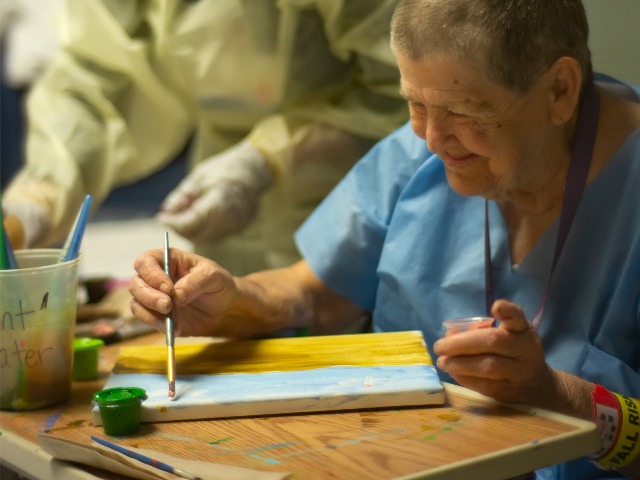ATN Blog - Researching the arts in health // Part Two

This is the second of a two-part description of arts in health. Part One focused on the theoretical basis for the field, and Part Two describes practical application in clinical and community settings.
What does arts in health practice look like?
In the clinical setting
To imagine arts in health (AiH) in action, picture a patient who is recovering from surgery, confined to a hospital bed. There is a knock on the patient’s door, and the patient says, “Come in.” A visual artist introduces herself, shows the patient a watercolor painting, asking if the patient would perhaps like to make one with the artist’s help? For patients who say ‘yes’ to being creative––and it must be the patient’s choice to participate in AiH––the artists are skilled at providing materials, encouragement and guidance without pressure or expectations. Even patients with no previous arts experience begin to relax, become curious, and find inspiration. The art form could be visual art, music, dance, creative writing (etc.), but the point is always to help the patient to engage with their imagination and creativity in a relaxed atmosphere.
Meanwhile, among nurses and doctors, compassion fatigue and stress can lead to a sense of meaninglessness, apathy, depression, and burnout. However, art-making helps reduce stress, can bring joy back into the workplace and help staff to make meaning from difficult work experiences. So, alongside their work with patients, AiH professionals are trained to work with hospital staff, finding time and space to be creative even within the famously busy schedules of doctors and nurses. Research suggests that having a creative work environment can reduce the frequency of staff turnover in hospitals.
In the community
Sharing the experience of making art can bring people together who otherwise might never have met. Sharing a creative experience can open up the possibility of sharing other shared concerns and interests. Community-based arts in health programs can help build community cohesion, which brings community members together around common goals like disease prevention.
As an example, imagine a town where all of the children are at high risk for abusing drugs. Within that town, smaller communities are sharply divided by race, or religion, or language, and those divisions make it difficult for residents to understand their shared problem, or to take collective action to prevent it. Because communities are complex and change slowly, an artist who wants to work in public health begins by making a long-term commitment, never telling the community what to do, but always assisting the community to use arts activities to investigate the problem, and to communicate and build bridges, and to move toward solutions.
Sometimes the artist finds an already-vibrant arts scene that only needs to be expanded to include a health perspective, and in other cases arts activities are an entirely new idea in the community. In either case, the artist helps residents to make their own art artwork, with the goal of widening and deepening social bonds, building networks of empathy and communication, and empowering community members to support healthy living and prevent disease.
Arts in health research in the Netherlands
Arts in health research contributes to some of the newest and most innovative thinking about healthcare, and around the world scientists and scholars are expanding our fundamental understanding of the links between creativity and health.[1] At the same time, this research also directly shapes the field’s practical understanding of what the arts can contribute to individual and collective wellbeing. Researchers in the Netherlands are making important contributions to that understanding, for example with the Meaningful Music in Health Care study of the effects of music among hospital patients, currently underway at University Medical Center Groningen.[2] Or the Kunst in de Zorg (Arts in Health) study at the Leiden Academy on the ‘value of art in care’.[3] All this research shapes and defines the actual practice of arts in health, so we can say that research not only makes new knowledge, but also impacts the wellbeing of hospital patients, caregivers, and communities.
About the author
Ferdinand Lewis, Ph.D., is on the faculty of University College Groningen, where he created and co-supervises an annual arts in health project with students. He is helping the Aletta Jacobs School of Public Health to establish an organization to professionalize the field of arts in health in Groningen and the North of the Netherlands.
This blog was made possible by the Aletta Talents Network. If you would like to contribute a blog for the ATN, please contact Tom at t.a.lowe rug.nl.
Click here to join the Aletta Talents Network!
[1] In 2000 the World Health Organization published a ‘scoping review’ of all the existing literature on the subject: https://www.euro.who.int/__data/assets/pdf_file/0005/419081/WHO_Arts_A5.pdf.
[2] http://www.mimicmuziek.nl/en/research/



